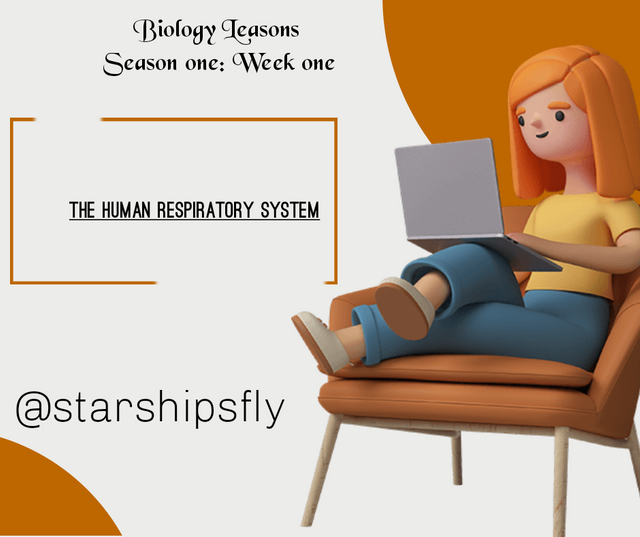Biology Lessons|| Season One: week one by @starshipsfly

Greetings to all great students and teachers of steem skillshare. I am really glad to share my Biology Lessons with everyone here today.
This is the very first class I am am holding and today lesson is about the human respiratory system.
The Mechanism of respiration in humans.
Inhalation : For this to occur, there has to be an exchange of gasses between the environment and the respiratory organs of the body. In this process, air or oxygen bus breathed in or inhaled into the lungs.
Exhalation: This is process of breathing out or exhaling carbon dioxide into the atmosphere.
The process of inhalation in the human body
The following are the process involved during inhalation
The volume of the thoracic cavity is increases.
Air from outside is induced into the lungs through the nose,trachea,bronchus and bronchioles which results to an increase in the size of the lungs.
The diaphragm becomes contracted and flattens.
The intercostal muscles contract
Then the sternum is moved forward.
Then there is a decrease in the pressure of the thoracic cavity as a result of it's increase in volume.
Following the inspiration of air, oxygen is then diffused into the blood capillaries of alveoli, while carbon dioxide and water diffuse out. This is then followed by the Expiration process.
The expiration process in the human body.
- The volume of the thoracic cavity decreases.
- The diaphragm becomes relaxed .
- The intercostal muscles also relax.
- The sternum now moves inwards.
- There is an increase in the pressure of the thoracic cavity due to its decrease in volume.
- The air that is in the lungs and alveoli which contains carbon dioxide and water vapour are forced out through the bronchioles,bronchi,trachea and finally through the nose.
This is a process by which glucose is broken down to release energy. This released energy is stored inform of Adenosine trisphosphate (ATP) which aids in the metabolic processes in the body.
There are two main types of cellular respiration.
Aerobic respiration: this is the type of respiration tht involves the break down of glucose into water, carbon dioxide and energy in the presence of oxygen.
Anaerobic Respiration:
This is a type of respiration that does not require the presence of oxygen in the breaking down of glucose to provide energy.
The mouth and nose: these are openings that helps in the breathing in of air in to the body.
Sinuses: this are hollow areas in the bones in the head that aids the regulation of humidity And temperature if the air that is inhaled.
The pharynx: these are tubes that transport air from the nose or mouth through the larynx down the trachea.
The larynx: this is the voice box.
The trachea: this connects the throat to the lungs.
The bronchial tubes: this are tubes that connect to the lubgs. The large air way is called the brochi which leads to the bronchioles.
The lungs: they are two organs that diffuses oxygen from air which is used in oxygenating blood.
Diaphragm
Alveoli
Aids in inhalation of air.
Aids the body's ability to talk and smell.
Delivers oxygen to the various organs where it is needed.
Removal of waste substances that can be harmful to the body through exhalation.
Protecting the airways from harmful substances.
I hope we all benefit from today's lessons.
Feel free to drop any questions about this topic.
Image edited with brand maker app
Hi @starshipsfly, I'm really interested in learning from your biology tutorials, I hope to keep reading your posts! Thanks for this interesting topic!
Am really glad my tutorials interests you. I will surely keep posting More.
Thank you for visiting my blog